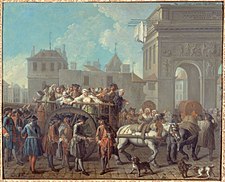Prostitution
| Occupation | |
|---|---|
Activity sectors | Sex industry |
| Description | |
Related jobs | Stripper, porn actor |
Prostitution is the business or practice of engaging in
Prostitution occurs in a variety of forms, and
According to a 2011 report by Fondation Scelles there are about 42 million prostitutes in the world, living all over the world (though most of Central Asia, the Middle East and Africa lack data, studied countries in that large region rank as top sex tourism destinations).[6] Estimates place the annual revenue generated by prostitution worldwide to be over $100 billion.[7]
The majority of prostitutes are female and have male clients.[8][9]
The position of prostitution and the law varies widely worldwide, reflecting differing opinions. Some view prostitution as a form of exploitation of or
Etymology and terminology
General
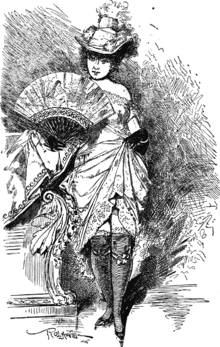
Prostitute is derived from the Latin prostituta. Some sources cite the verb as a composition of "pro" meaning "up front" or "forward" and "stituere", defined as "to offer up for sale".[16] Another explanation is that prostituta is a composition of pro and statuere (to cause to stand, to station, place erect). A literal translation therefore is: "to put up front for sale" or "to place forward". The Online Etymology Dictionary states, "The notion of 'sex for hire' is not inherent in the etymology, which rather suggests one 'exposed to lust' or sex 'indiscriminately offered.'"[17][18]
The word prostitute was then carried down through various languages to the present-day Western society. Most
A variety of terms are used for those who engage in prostitution, some of which distinguish between different types of prostitution or imply a value judgment about them. This terminology is hotly contested among scholars.[21] Common alternatives for prostitute include escort and whore; however, not all professional escorts are prostitutes.
The English word whore derives from the Old English word hōra, from the Proto-Germanic *hōrōn (prostitute), which derives from the Proto-Indo-European root *keh₂- meaning "desire", a root which has also given us Latin cārus (dear), whence the French cher (dear, expensive) and the Latin cāritās (love, charity). Use of the word whore is widely considered pejorative, especially in its modern slang form of ho. In Germany, however, most prostitutes' organizations deliberately use the word Hure (whore) since they feel that prostitute is a bureaucratic term.[citation needed]
Those seeking to remove the social stigma associated with prostitution often promote terminology such as makes appointments by phone, or in recent years, through email or the internet.
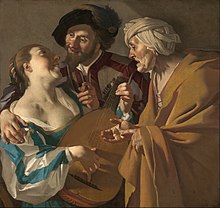
Correctly or not, the use of the word prostitute without specifying a sex may commonly be assumed to be female; compound terms such as male prostitution or male escort are therefore often used to identify males. Those offering services to female customers are commonly known as gigolos; those offering services to male customers are hustlers or rent boys.
Procuring
Organizers of prostitution may be known colloquially as
Examples of procuring include:
- deriving financial gain from the prostitution of another
- operating a prostitution business
- trafficking a person into a country for the purpose of soliciting sex
- transporting a prostitute to the location of their arrangement
Clients
Clients of prostitutes, most often men by prevalence, are sometimes known as johns or tricks in North America and punters in Britain and Ireland. These slang terms are used among both prostitutes and law enforcement for persons who solicit prostitutes.[24] The term john may have originated from the frequent customer practice of giving one's name as "John", a common name in English-speaking countries, in an effort to maintain anonymity. In some places, men who drive around red-light districts for the purpose of soliciting prostitutes are also known as kerb crawlers.
Female clients of prostitutes are sometimes referred to as janes or sugar mamas.[25][26][27]
Other meanings
The word "prostitution" can also be used metaphorically to mean debasing oneself or working towards an unworthy cause or "selling out".
The prostitution metaphor, "traditionally used to signify political inconstancy, unreliability, fickleness, a lack of firm values and integrity, and venality, has long been a staple of Russian political rhetoric.
Besides targeting political figures, the term is used in relation to organizations and even small countries, which "have no choice but to sell themselves", because their voice in world affairs is insignificant. In 2007, a Russian caricature depicted the Baltic states as three "ladies of the night", "vying for the attentions of Uncle Sam, since the Russian client has run out of money".[29]
Usage of the "political prostitute" moniker is by no means unique to the Russian political lexicon, such as when a
Sex work researcher and writer Gail Pheterson writes that these metaphorical usages exist because "the term prostitute gradually took on a Christian moralist tradition, as being synonymous with debasement of oneself or of others for the purpose of ill-gotten gains".[33]
History
Europe
Ancient
Although historically it was suggested that peoples of the
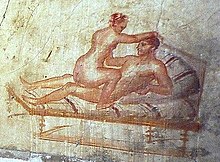
There was never a unified legal approach to prostitution in ancient Rome.[38] In ancient Rome, prostitutes had low social status and were considered infamia.[39] Under the reign of emperor Caligula, a taxation on prostitution was implemented.[38] Roman slave owners were able to include the ne serva prostituatur covenant as part of slave sale contracts, which prohibited the slaves being forced to prostitute themselves by their owners after being sold.[40]
Middle Ages
Throughout the
In urban societies there was an erroneous view that prostitution was flourishing more in rural regions rather than in cities, however, it has been proven that prostitution was more rampant in cities and large towns.[48] Although there were wandering prostitutes in rural areas who worked according to the calendar of fairs, similar to riding a circuit, in which prostitutes stopped by various towns based on what event was going on at the time, most prostitutes remained in cities. Cities tended to draw more prostitutes due to the sheer size of the population and the institutionalization of prostitution in urban areas which made it more rampant in metropolitan regions.[48] Furthermore, in both urban and rural areas of society, women who did not live under the rule of male authority were more likely to be suspected of prostitution than their oppressed counterparts because of the fear of women who did not fit into a stereotypical category outside of marriage or religious life.[44]
Secular law, like most other aspects of prostitution in the Middle Ages, is difficult to generalize due to the regional variations in attitudes towards prostitution.
Sumptuary laws became the regulatory norm for prostitutes and included making
Although brothels were still present in most cities and urban centers and could range from private bordelages run by a procuress from her home to public baths and centers established by municipal legislation, the only centers for prostitution legally allowed were the institutionalized and publicly funded brothels.[54] This did not prevent illegal brothels from thriving. Brothels theoretically banned the patronage of married men and clergy, but it was sporadically enforced and there is evidence of clergymen present in brawls that were documented in brothels.[55] Thus the clergy were at least present in brothels at some point or another. Brothels also settled the "obsessive fear of the sharing of women" and solved the issue of "collective security."[56] The lives of prostitutes in brothels were not cloistered like that of nuns and "only some lived permanently in the streets assigned to them."[57] Prostitutes were only allowed to practice their trade in the brothel in which they worked.[58] Brothels were also used to protect prostitutes and their clients through various regulations. For example, the law that "forbid brothel keepers [from] beat[ing] them."[59] However, brothel regulations also hindered prostitutes' lives by forbidding them from having "lovers other than their customers" or from having a favored customer.[59]
Courts showed conflicting views on the role of prostitutes in secular law as prostitutes could not inherit property, defend themselves in court, or make accusations in court.[60] However, prostitutes were sometimes called upon as witnesses during trial.[61]

16th–present
By the end of the 15th-century attitudes seemed to have begun to harden against prostitution. An outbreak of
The Church's stance on prostitution was three-fold: "acceptance of prostitution as an inevitable social fact, condemnation of those profiting from this commerce, and encouragement for the prostitute to
With the advent of the
In the 19th century, legalized prostitution became the center of public controversy as the British government passed the Contagious Diseases Acts, legislation mandating pelvic examinations for suspected prostitutes; they would remain in force until 1886. The French government, instead of trying to outlaw prostitution, began to view prostitution as a necessary evil for society to function. French politicians chose to regulate prostitution, introducing a "Morals Brigade" onto the streets of Paris.[74] A similar situation did in fact exist in the Russian Empire; prostitutes operating out of government-sanctioned brothels were given yellow internal passports signifying their status and were subjected to weekly physical exams. A major work, Prostitution, Considered in Its Moral, Social, and Sanitary Aspects, was published by William Acton in 1857, which estimated that the County of London had 80,000 prostitutes and that 1 house in 60 was serving as a brothel.[75] Leo Tolstoy's novel Resurrection describes legal prostitution in 19th-century Russia.
The leading
In 1956, the United Kingdom introduced the Sexual Offences Act 1956. While this law did not criminalise the act of prostitution in the United Kingdom itself, it prohibited such activities as running a brothel. Soliciting was made illegal by the Street Offences Act 1959. These laws were partly repealed, and altered, by the Sexual Offences Act 2003 and the Policing and Crime Act 2009.
Since the break up of the Soviet Union, thousands of eastern European women end up as prostitutes in China, Western Europe, Israel, and Turkey every year. Some enter the profession willingly; many are tricked, coerced, or kidnapped, and often experience captivity and violence.[78] There are tens of thousands of women from eastern Europe and Asia working as prostitutes in Dubai. Men from Saudi Arabia and the United Arab Emirates form a large proportion of the customers.[79]
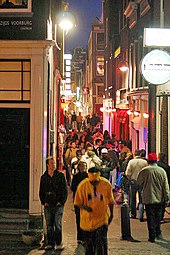
Middle East
In the Islamic world, sex outside of marriage was normally acquired by men not by paying for temporary sex from a free sex worker, but rather by personal sex slave called
Traditionally, prostitution in the Islamic world was historically practiced by way of the pimp temporarily selling his slave to her client, who then returned the ownership of the slave after intercourse. The Islamic Law formally prohibited prostitution. However, since Islamic Law allowed a man to have sexual intercourse with his
According to
According to
East Asia
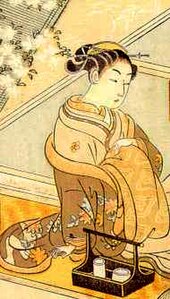
In the early 17th century, there was widespread male and female prostitution throughout the cities of
Japanese prostitutes were held in high regard by European travelling men in the 19th century. A British army officer reported that Japanese women were the best prostitutes in the world, for their attractiveness, cleanliness, and intelligence.[97]
South Asia
The Mahabharata and the Matsya Purana mention fictitious accounts of the origin of Prostitution. Although, Later Vedic texts tacitly, as well as overtly, mention Prostitutes, it is in the Buddhist literature that professional prostitutes are noticed.[98] A tawaif was a courtesan who catered to the nobility of the Indian subcontinent, particularly during the era of the Mughal Empire. These courtesans danced, sang, recited poetry and entertained their suitors at mehfils. Like the geisha tradition in Japan, their main purpose was to professionally entertain their guests, and while sex was often incidental, it was not assured contractually. High-class or the most popular tawaifs could often pick and choose between the best of their suitors. They contributed to music, dance, theatre, film, and the Urdu literary tradition.[99]
During the East India Company's rule in India from 1757 until 1857, it was common for European soldiers serving in the presidency armies to solicit the services of Indian prostitutes, and they frequently paid visits to local nautch dancers for purposes of a sexual nature.[100] Prostitutes from Japan were also popular. Asian prostitutes were held in higher regard than prostitutes from Europe because they came from higher social backgrounds and were regarded as cleaner, more attractive and entertaining than prostitutes back in Europe.[97]
In the 21st century, Afghans revived a method of prostituting young boys which is referred to as "bacha bazi".[101]
India's
Americas
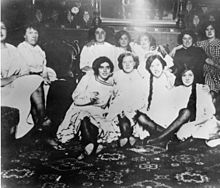

In Latin America and the Caribbean sex worker movements date back to the late 19th century in Havana, Cuba. A catalyst in the movement being a newspaper published by Havana sex workers. This publication went by the name La Cebolla, created by Las Horizontales.[103]
During this period, prostitution was also very prominent in the
Originally, prostitution was widely legal in the United States. Prostitution was made illegal in almost all states between 1910 and 1915 largely due to the influence of the Woman's Christian Temperance Union.[106][107]
On the other hand, prostitution generated much national revenue in South Korea, hence the military government encouraged
Beginning in the late 1980s, many states in the US increased the penalties for prostitution in cases where the prostitute is knowingly HIV-positive. Penalties for felony prostitution vary, with maximum sentences of typically 10 to 15 years in prison.
Sex tourism emerged in the late 20th century as a controversial aspect of Western tourism and globalization.
Historically, and currently, church prostitutes exist, and the practice may be legal or illegal, depending on the country, state or province.[110]
Economics
Prostitutes' salaries and payments fluctuate according to the economic conditions of their respective countries. Prostitutes who usually have foreign clients, such as business travelers, depend on good foreign economic conditions.[111] Payment may vary according to regulations made by pimps, brothel keepers, madams, and procurers, who usually take a slice out of a prostitute's income.[112] Prices may further depend on demand; popular, high-end prostitutes can earn significant amounts of money (upwards of $5,000 per client),[113] and virgins may receive even higher payments.
Laws
The Harlot's Progress, showing brothel-keeper Elizabeth Needham , on the right, procuring a young woman who has just arrived in London
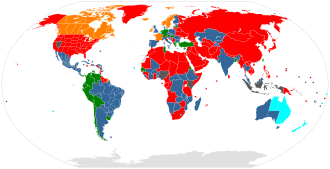 Legalization – prostitution legal and regulated Decriminalization – No criminal penalties for prostitution Abolitionism – prostitution is legal, but organized activities such as brothels and pimping are illegal; prostitution is not regulated Neo-abolitionism – illegal to buy sex and for 3rd party involvement, legal to sell sex Prohibitionism – prostitution illegal Legality varies with local laws The position of prostitution and the law varies widely worldwide,[114] reflecting differing opinions on victimhood and exploitation, inequality, gender roles, gender equality, ethics and morality, freedom of choice, historical social norms, and social costs and benefits. Legal themes tend to address four types of issues: victimhood (including potential victimhood), ethics and morality, freedom of choice, and general benefit or harm to society (including harm arising indirectly from matters connected to prostitution). Prostitution may be considered a form of exploitation (e.g., Sweden, Norway, Iceland, where it is illegal to buy sexual services, but not to sell them—the client commits a crime, but not the prostitute), a legitimate occupation (e.g., Netherlands, Germany, where prostitution is regulated as a profession) or a crime (e.g., many Muslim countries, where the prostitutes face severe penalties).
The legal status of prostitution varies from country to country, from being legal and considered a regulated .
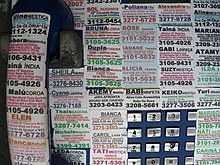 In some countries, there is controversy regarding the laws applicable to sex work. For instance, the legal stance of punishing pimping while keeping sex work legal but "underground" and risky is often denounced as hypocritical; opponents suggest either going the full abolition route and criminalize clients or making sex work a regulated business. Other groups, often with religious backgrounds, focus on offering women a way out of the world of prostitution while not taking a position on the legal question. Prostitution is a significant issue in feminist thought and activism. Many feminists are opposed to prostitution, which they see as a form of exploitation of women and male dominance over women, and as a practice that is the result of the existing patriarchal societal order. These feminists argue that prostitution has a very negative effect, both on the prostitutes themselves and on society as a whole, as it reinforces stereotypical views about women, who are seen as sex objects which can be used and abused by men. Other feminists hold that prostitution can be a valid choice for the women who choose to engage in it; in this view, prostitution must be differentiated from forced prostitution, and feminists should support sex worker activism against abuses by both the sex industry and the legal system. DecriminalizationDecriminalization views prostitution as labor like any other and that the sex industry premises should not be subject to any special regulation or laws. This is the current situation in New Zealand; the laws against operating a brothel, pimping, and street prostitution are struck down, but prostitution is hardly regulated at all. Proponents of this view often cite instances of government regulation under legalization that they consider intrusive, demeaning, or violent, but feel that criminalization adversely affects sex workers.[116] Amnesty International is one of the notable groups calling for the decriminalization of prostitution.[117][15][118] 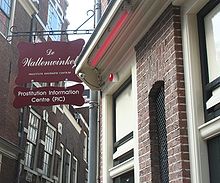 Many countries have sex worker advocacy groups that lobby against criminalization and discrimination of prostitutes. These groups generally oppose Nevada-style regulation and oversight, stating that prostitution should be treated like other professions. In the United States of America, one such group is International Committee for Prostitutes' Rights and the Network of Sex Work Projects.[121]
LegalizationSome view prostitution as something to be legalized and regulated: prostitution may be considered a legitimate business; prostitution and the employment of prostitutes are legal, but regulated. This is the current situation in the Netherlands, Germany,[122] most of Australia and parts of Nevada (see Prostitution in Nevada). The degree of regulation varies very much; for example, in the Netherlands, prostitutes are not required to undergo mandatory health checks (see Prostitution in the Netherlands), while in Nevada, the regulations are very strict (see Prostitution in Nevada). Because prostitution is considered criminal in many jurisdictions, its substantial revenues are not contributing to the tax revenues of the state, and its workers are not routinely screened for sexually transmitted infections which is dangerous in cultures favouring unprotected sex and leads to significant expenditure in the health services. According to the 1992 Estimates of the costs of crime in Australia report, there was an "estimated $96 million loss of taxation revenue from undeclared earnings of prostitution".[123] AbolitionismIn pimping are prohibited. This is to some extent the current situation in Great Britain, where prostitution is considered "both a public nuisance and sexual offence", and Italy among others.[124]
Neo-abolitionismNeo-abolitionism view prostitution as inherently abusive and a form of violence against women.[125] Prostitutes are not prosecuted, but their clients and pimps are. In 1999, after lobbying by a coalition of feminists and Christians, Sweden criminalized the buying, not the selling, of sex and neo-abolitionism has come to also be known as the "Nordic model". It has since become law in France, Norway and Iceland (in Norway the law is even more strict, forbidding also having sex with a prostitute abroad).[126] Exxpose, a Dutch group led by evangelical students gathered 40,000 signatures for a petition for the Dutch parliament to adopt the Swedish model but were unsuccessful.[127] Advocates feel that legalizing and regulating prostitution creates a parallel illegal prostitution industry, and fails to dissociate the legal part of the sex trade from crime.[128][129][130][131]
In 1949, the UN General Assembly adopted a convention stating that "prostitution and the accompanying evil of the traffic in persons for the purpose of prostitution are incompatible with the dignity and worth of the human person",[132] requiring all signing parties to punish pimps and brothel owners and operators and to abolish all special treatment or registration of prostitutes. As of January 2009, the convention was ratified by 95 member nations including France, Spain, Italy, Denmark, and not ratified by another 97 member nations including Germany, the Netherlands, the United Kingdom, and the United States.
In February 2014, the members of the European Parliament voted in a non-binding resolution, (adopted by 343 votes to 139; with 105 abstentions), in favor of the 'Swedish Model' of criminalizing the buying, but not the selling of sex.[133] ProhibitionismIn prohibitionism, both prostitutes and clients are criminalized and are seen as immoral, they are considered criminals. This is the prevailing attitude nearly everywhere in the United States, with a few exceptions in some rural Nevada counties (see Prostitution in Nevada) Survival sexSurvival sex is when the prostitute is driven to prostitution by a need for basic necessities such as food or shelter. Drug addictsDrug addiction is associated with increased odds of survival sex work.[134] HomelessResearchers estimate that of homeless youth in North America, one in three has engaged in survival sex. In one study of homeless youth in Los Angeles, about one-third of females and half of males said they had engaged in survival sex.[135][136][137]
RefugeesSurvival sex is common in internally displaced persons camps in northern Uganda, where 1.4 million civilians have been displaced by conflict between Ugandan government forces and the militant Lord's Resistance Army, Human Rights Watch reported in 2005 that displaced women and girls were engaging in survival sex with other camp residents, local defense personnel, and Ugandan government soldiers.[138]
Illegal migrantsA difficulty facing migrant prostitutes in many developed countries is the illegal residence status of some of these women. They face potential deportation, and so do not have recourse to the law. This increases their fear of reporting violence they may suffer, due to their fear of being deported, as well as fear of reprisal from human traffickers.[139][140] The immigration status of the persons who sell sexual services is—particularly in Western Europe—a controversial and highly debated political issue. Currently, in most of these countries, most prostitutes are immigrants, mainly from Eastern and Central Europe; in Spain and Italy 90% of prostitutes are estimated to be migrants, in Austria 78%, in Switzerland 75%, in Greece 73%, in Norway 70% (according to a 2009 TAMPEP report, Sex Work in Europe-A mapping of the prostitution scene in 25 European countries).[141] An article in Le Monde diplomatique in 1997 stated that 80% of prostitutes in Amsterdam were foreigners and 70% had no immigration papers.[142] Caste prostitutes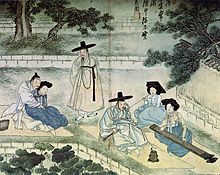 Castes are largely hereditary social classes often emerging around certain professions. Lower castes are associated with professions considered "unclean", which has often included prostitution. In pre-modern Korea, some women from the ElderlyProstitution among the elderly is a phenomenon reported in State pensions of about ₩200,000 (US$168) provide a basic income but are often not enough to cover the rising medical bills of old age. It first arose after the 1997 Asian financial crisis when it became more difficult for children and grandchildren to support their elders. Clients tend to be more senior. The use of erection-inducing injections with reused needles has contributed to the spread of sexually transmitted infections.[149][150]
Forced prostitutionforced in to sexual slavery by the Japanese military sits on a stretcher and speaks to a British military serviceman.[151] Sex trafficking is defined as using coercion or force to transport an unwilling person into prostitution or other sexual exploitation.[152] The United Nations stated in 2009 that sex trafficking is the most commonly identified form of human trafficking and estimates that about 79% of human trafficking reported is for prostitution (although the study notes that this may be the result of statistical bias and that sex trafficking tends to receive the most attention and be the most visible).[153] Sex trafficking has been described by Kul Gautum, deputy executive director of UNICEF, as "the largest slave trade in history."[154] It is also the fastest growing criminal industry, predicted to outgrow drug trafficking.[155][156][157] While there may be a higher number of people involved in slavery today than at any time in history, the proportion of the population is probably the smallest in history.[158][159] "Annually, according to U.S. Government-sponsored research completed in 2006, approximately 800,000 people are trafficked across national borders, which does not include millions trafficked within their own countries. Approximately 80 percent of transnational victims are women and girls and up to 50 percent are minors", estimated the US Department of State in a 2008 study, in reference to the number of people estimated to be victims of all forms of human trafficking.[160] Due in part to the illegal and underground nature of sex trafficking, the actual extent of women and children forced into prostitution is unknown. A statistical analysis of various measures of trafficking found that the legal status of prostitution did not have a significant impact on trafficking.[13] Globally, forced labour generates an estimated $31 billion, about half of it in the industrialized world and around one-tenth in transitional countries, according to the International Labour Organization (ILO) in a report on forced labour ("A global alliance against forced labour", ILO, 11 May 2005).[161] International trafficking of people has been heavily facilitated by communication technologies.[162] The most common destinations for victims of human trafficking are Thailand, Japan, Israel, Belgium, the Netherlands, Germany, Italy, Turkey, and the US, according to a report by the UNODC (UN Office on Drugs and Crime).[163] Major sources of trafficked persons include Thailand, China, Nigeria, Albania, Bulgaria, Belarus, Moldova, and Ukraine.[163] The legalization of buying sex is associated with higher human trafficking inflows than countries where it is prohibited. The type of legalization, such as allowing third-party involvement (i.e, “pimps”), is not shown to make a difference in the effect of sex trafficking inflows.[164] Use of childrenRegarding the prostitution of children the laws on prostitution as well as those on sex with a child apply. If prostitution, in general, is legal there is usually a minimum age requirement for legal prostitution that is higher than the general age of consent (see above for some examples). In the early 1990s, some countries, mainly in Latin America, did not single out patronage of child prostitution as a separate crime.[165] According to Steinman (2002), by the early 2000s, several such countries had passed laws against child prostitution, yet they were weakly enforced, and pimps continued to profit from the exploitation of minors in Latin America.[166]
Children are sold into the global sex trade every year. Often they are kidnapped or orphaned, and sometimes they are sold by their own families. According to the International Labour Organization, the occurrence is especially common in places such as Thailand, the Philippines, Sri Lanka, Vietnam, Cambodia, Nepal, and India.[167] In India, the federal police say that around 1.2 million children are believed to be involved in prostitution.[168] A CBI statement said that studies and surveys sponsored by the ministry of women and child development estimated that about 40% of all India's prostitutes are children.[168] In Bangladesh, child prostitutes are known to take the drug Oradexon, also known as Thailand's Health System Research Institute reported that children in prostitution make up 40% of prostitutes in Thailand.[172] Some adults travel to other countries to have access to sex with children, which is unavailable in their home country. Cambodia has become a notorious destination for sex with children.[173][174] Thailand is also a destination for child sex tourism.[174][175] Several western countries have recently enacted laws with extraterritorial reach, punishing citizens who engage in sex with minors in other countries. As the crime usually goes undiscovered, these laws are rarely enforced.[176][177][178] Socio-economic issuesDisabilityProstitution is seen by some people with disabilities, or some people with neurological differences – such as some on the autism spectrum – to be an effective way to have sexual experiences, find intimacy, and/or receive human affection that may be difficult for them to come by via traditional means and that may be lacking in their lives.[179][180] A poll by The Observer in 2008 indicated that 70% of Britons would not consider having sex with someone who has a physical disability.[179] Some people that have disabilities are referred to prostitutes by friends or family, such as a parent or guardian, carers, or support workers.[181] In 2021, a UK judge ruled that council care workers can help disabled people meet prostitutes without breaking the law.[182] Prostitutes that cater to people with disabilities have argued that people with disabilities have the same needs and desires as everyone else.[181] In some countries such as Denmark and the Netherlands access to sex workers for those with disabilities is funded by the state on the basis that sexuality is a human right and leads to improved well-being for people with disabilities.[183][184] ExtortionProstitution, often when it is illegal, is used in extortion and blackmail, which always involves extortion, where the extortionist threatens to reveal information about a victim or their family members that is potentially embarrassing, socially damaging, or incriminating unless a demand for money, property, or services is met. The subject of the extortion may be manipulated into or voluntarily solicit the use of prostitution which is then later used to extort money or for profit otherwise. The film The Godfather Part II famously depicts the role of Senator Geary who is implicated in the use of prostitution in order to gain his compliance on political issues.[185] Procurement methodsIn countries where prostitution is legal, advertising it may be legal (as in the Netherlands) or illegal (as in India). Covert advertising for prostitution can take a number of forms:
In the United States, massage parlors serving as a cover for prostitution may advertise "full service", a euphemism for coitus.[186] In Las Vegas, prostitution is often promoted overtly on the Las Vegas Strip by third party workers distributing risque flyers with the pictures and phone numbers of escorts (despite the fact that prostitution is illegal in Las Vegas and Clark County, see Prostitution in Nevada). The way in which prostitutes advertise their presence varies widely. Some remain in apartments that have hints or clues outside such as posters with "model" written on them to lure potential customers inside. Others advertise by putting numbers or locations in phoneboxes or in online or newspaper ads. In more sexually permissive societies, prostitutes can advertise in public view, such as through display windows. In sexually restrictive societies it may occur through word-of-mouth and other means.[187] Street In street prostitution, the prostitute solicits customers while waiting at street corners, sometimes called "the track" by pimps and prostitutes alike. They usually dress in skimpy, provocative clothing, regardless of the weather. In American usage, street prostitutes are often called "streetwalkers" while their customers are referred to as "tricks" or "johns". Servicing the customers is described as "turning tricks". The sex is usually performed in the customer's car, in a nearby alley, or in a rented room. Motels and hotels that accommodate prostitutes commonly rent rooms by half or full hour.
In Russia and other countries of the former USSR, prostitution takes the form of an open-air market. One prostitute stands by a roadside and directs cars to a so-called "tochka" (usually located in alleyways or carparks), where lines of women are paraded for customers in front of their car headlights. The client selects a prostitute, whom he takes away in his car. Prevalent in the late 1990s, this type of service has been steadily declining in recent years. A "lot lizard" is a commonly encountered special case of street prostitution. Window prostitution Window prostitution is a form of prostitution that is fairly common in the Netherlands and surrounding countries.[189] The prostitute rents a window plus workspace off a window operator for a certain period of time, often per day or part of a day.[190][191][192] The prostitute is also independent and recruits her own customers and also negotiates the price and the services to be provided.[190][191][192] BrothelsIranian flag blacked out after protests and threats.Brothels are establishments specifically dedicated to prostitution, often confined to special red-light districts in big cities. Other names for brothels include bordello, whorehouse, cathouse, knocking shop, and general houses. Prostitution also occurs in some massage parlours, and in Asian countries in some barber shops where sexual services may be offered as a secondary function of the premises. Escorts Escort services may be distinguished from prostitution or other forms of prostitution in that sexual activities are often not explicitly advertised as necessarily included in these services; rather, payment is often noted as being for an escort's time and companionship only, although there is often an implicit assumption that sexual activities are expected. In escort prostitution, the act takes place at the customer's residence or hotel room (referred to as out-call), or at the escort's residence, or in a hotel room rented for the occasion by the escort (called in-call). The prostitute may be independent or working under the auspices of an escort agency. Services may be advertised over the Internet, in regional publications, or in local telephone listings. Use of the Internet by prostitutes and customers is common.[194] A prostitute may use adult boards or create a website of their own with contact details, such as email addresses. Adult contact sites, chats, and online communities are also used. This, in turn, has brought increased scrutiny from law enforcement, public officials, and activist groups toward online prostitution. In 2009, Craigslist came under fire for its role in facilitating online prostitution, and was sued by some 40 US state attorneys general, local prosecutors, and law enforcement officials. Reviews of the services of individual prostitutes can often be found at various escort review boards worldwide. These online forums are used to trade information between potential clients, and also by prostitutes to advertise the various services available. Sex workers, in turn, often use online forums of their own to exchange information on clients, particularly to warn others about dangerous clients.
Sex tourismWorld Tourism Organization, a specialized agency of the United Nations defines sex tourism as "trips organized from within the tourism sector, or from outside this sector but using its structures and networks, with the primary purpose of effecting a commercial sexual relationship by the tourist with residents at the destination".[195]
As opposed to regular sex tourism, which is often legal, a tourist who has sex with a child prostitute will usually be committing a crime in the host country, under the laws of his own country (notwithstanding him being outside of it) and against international law. Child sex tourism (CST) is defined as travel to a foreign country for the purpose of engaging in commercially facilitated child sexual abuse.[196] Thailand, Cambodia, India, Brazil, and Mexico have been identified as leading hotspots of child sexual exploitation.[197] Virtual sexcamgirl ).
OrganizationLabor unionsThe labor union for sex workers and is affiliated with the general trade union, GMB .
CommunitiesVadia, India is known locally as the village of prostitutes, where unmarried women are involved in prostitution. Mass weddings for children of prostitutes in the village are held to protect them from being pushed into prostitution.[200]
Prevalence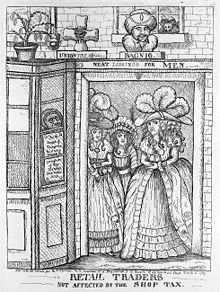 Oude Kerk, in Amsterdam's red-light district De Wallen . Titled Belle, the inscription to the piece says "Respect sex workers all over the world."According to the paper "Estimating the prevalence and career longevity of prostitute women",[201] the number of full-time equivalent prostitutes in a typical area in the United States (Colorado Springs, CO, during 1970–1988) is estimated at 23 per 100,000 population (0.023%), of which some 4% were under 18. The length of these prostitutes' working careers was estimated at a mean of 5 years. According to a 2012 report by Fondation Scelles there are between 40 and 42 million prostitutes in the world.[202] In 2003, it was estimated that in Amsterdam, one woman in 35 was working as a prostitute, compared to one in 300 in London.[203] The number of men who have used a prostitute at least once varies widely from country to country, from an estimated low of between 7%[204] and 8.8%[205] in the United Kingdom, to a high of between 59% and 80% in Cambodia.[206] A study conducted by ProCon – a nonpartisan nonprofit organization – estimated the percentage of men who had paid for sex at least once in their lives, and found the highest rates in Cambodia (between 59 and 80% of men had paid for sex at least once) and Thailand (an estimated 75%), followed by Italy (16.7–45%), Spain (27–39%), Japan (37%), the Netherlands (13.5–21.6%), the United States (15.0–20.0%), and China (6.4-20%).[206] Nations with higher rates of prostitution clients display much more positive attitudes towards commercial sex.[206] In some countries, such as Cambodia and Thailand, sex with prostitutes is considered commonplace and men who do not engage in commercial sex may be considered unusual by their peers.[206] In Thailand, it has been reported that about 75% of men have visited a prostitute at least once in their lifetimes. In Cambodia, that figure is 59% to 80%.[206] In the United States, a 2004 TNS poll reported 15% of all men admitted to having paid for sex at least once in their life.[207] However, a paper entitled "Prostitution and the sex discrepancy in reported number of sexual partners" concluded that men's self-reporting of prostitutes as sexual partners provides a serious underestimate.[208] In Australia, a survey conducted in the early 2000s showed that 15.6% of men aged 16–59 reported paying for sex at least once in their life, and 1.9% had done so in the past year.[209] Reports disagree on whether prostitution levels are growing or declining in developed countries. Some studies indicate that the percentage of men engaging in commercial sex in the United States has declined significantly in recent decades: in 1964, an estimated 69–80% of men had paid for sex at least once.[206] Some have suggested that prostitution levels have fallen in sexually liberal countries, most likely because of the increased availability of non-commercial, non-marital sex[210] or, for example in Sweden, because of stricter legal penalties.[211] Other reports suggest a growth in prostitution levels, for example in the US,[212] where again, sexual liberalisation is suggested as the cause. As Norma Ramos, executive director of the Coalition Against Trafficking in Women says "The more the commercial sex industry normalizes this behavior, the more of this behavior you get".[213]
Prostitutes have long plied their trades to the military in many cultures. For example, the British naval port of Portsmouth had a flourishing local sex industry in the 19th century, and until the early 1990s there were large red-light districts near American military bases in the Philippines. The notorious Patpong entertainment district in Bangkok, Thailand, started as an R&R location for US troops serving in the Vietnam War in the early 1970s. Washington D.C. itself had Murder Bay which attracted the military of the Civil War. Violence against prostitutesStreet prostitutes are at higher risk of violent crime than brothel prostitutes and bar prostitutes.[214][215] In the United States, the homicide rate for female prostitutes was estimated to be 204 per 100,000.[216] There are substantial differences in rates of victimization between street prostitutes and indoor prostitutes who work as escorts, call girls, or in brothels and massage parlors.[217][218] Violence against male prostitutes is less common.[219] The call to decriminalize selling sex is in part to reduce harm and violence. Under criminalization, prostitutes become more vulnerable to be victims of crimes, even by serial killers, because those committing crimes know that prostitutes would be less likely to report such crimes to the police as they would risk arrest. Additionaly, this puts prostitutes at risk of violence by police as police are able to extort prostitutes by threatening arrest. The ACLU, Human Rights Watch and Amnesty International argue that, in addition to decriminalize selling sex as in the Nordic model, decriminalizing buying sex makes it more safer for prostitutes.[220][221][222]
Medical situationIn some places, prostitution may be associated with the spread of sexually transmitted infections (STIs). Lack of condom use among prostitutes and their clients has been cited as a factor in the spread of HIV in Asia: "One of the main reasons for the rapid spread of HIV in Asian countries is the massive transmission among sex workers and clients".[223] As a result, prevention campaigns aimed at increasing condom use by sex workers have been attributed to play a major role in restricting the spread of HIV.[224] One of the sources for the spread of HIV in Africa is prostitution, with one study finding that encounters with prostitutes produced 84% of new HIV infections in adult males in Accra, Ghana.[225] The spread of HIV from urban settings to rural areas in Africa has been attributed to the mobility of farmers who visit sex workers in cities, for example in Ethiopia.[226] Some studies of prostitution in urban settings in developing countries, such as Kenya, have stated that prostitution acts as a reservoir of STIs within the general population.[227] Typical responses to the problem are:
Some think that the first two measures are counter-productive. Banning prostitution tends to drive it underground, making safe sex promotion, treatment, and monitoring more difficult. Registering prostitutes makes the state complicit in prostitution and does not address the health risks of unregistered prostitutes. Both of the last two measures can be viewed as harm reduction policies. In countries and areas where safer sex precautions are either unavailable or not practiced for cultural reasons, prostitution is an active disease vector for all STIs, including HIV/AIDS, but the encouragement of UN Secretary-General Ban Ki-moon urged all countries to remove bans on prostitution and homosexual sex, because "such laws constitute major barriers to reaching key populations with HIV services". In 2012, the Global Commission on HIV and the Law, which was convened by Ban Ki-moon, and which is an independent body, was established at the request of the UNAIDS, and supported by a Secretariat based at the UNDP,[229] reached the same conclusions, also recommending decriminalization of brothels and procuring.[230][231][232] Nevertheless, the report states that: "The content, analysis, opinions and policy recommendations contained in this publication do not necessarily reflect the views of the United Nations Development Programme."[229]
The COVID-19 pandemic has had an impact on sex work. During the COVID-19 pandemic, contact professions (which includes prostitution, amongst others) had been banned (temporarily) in some countries. This has resulted in a local reduction of prostitution.[233] Psychological issuesDe Marneffe (2009) argued that there are psychological issues that prostitutes face from certain experiences and through the duration or repetition. Some go through experiences that may result "in lasting feelings of worthlessness, shame, and self-hatred". De Marneffe further argued that this may affect the prostitute's ability to perform sexual acts for the purpose of building a trusting intimate relationship, which may be important for their partner. The lack of a healthy relationship can lead to higher divorce rates and can influence unhealthy relationship to their children, influencing their future relationships.[234] See also
ReferencesNotes
Bibliography
Further reading
External links
|


